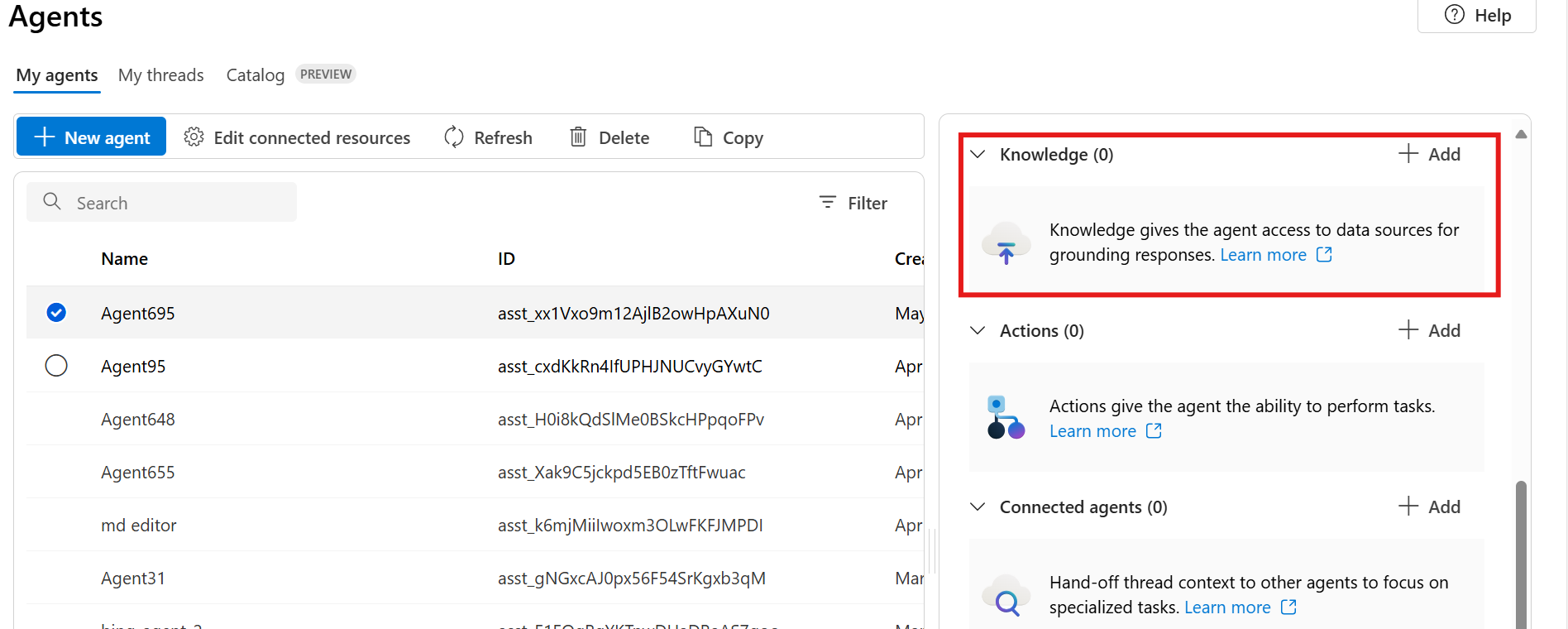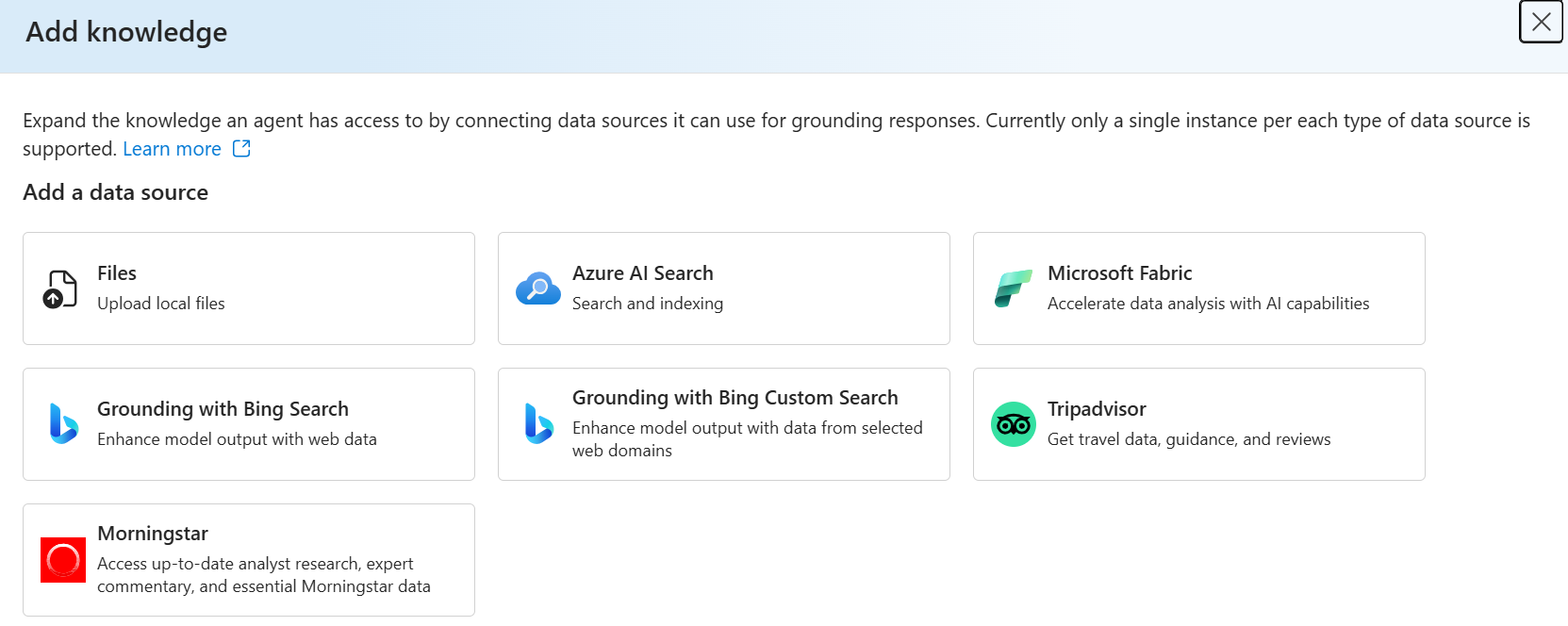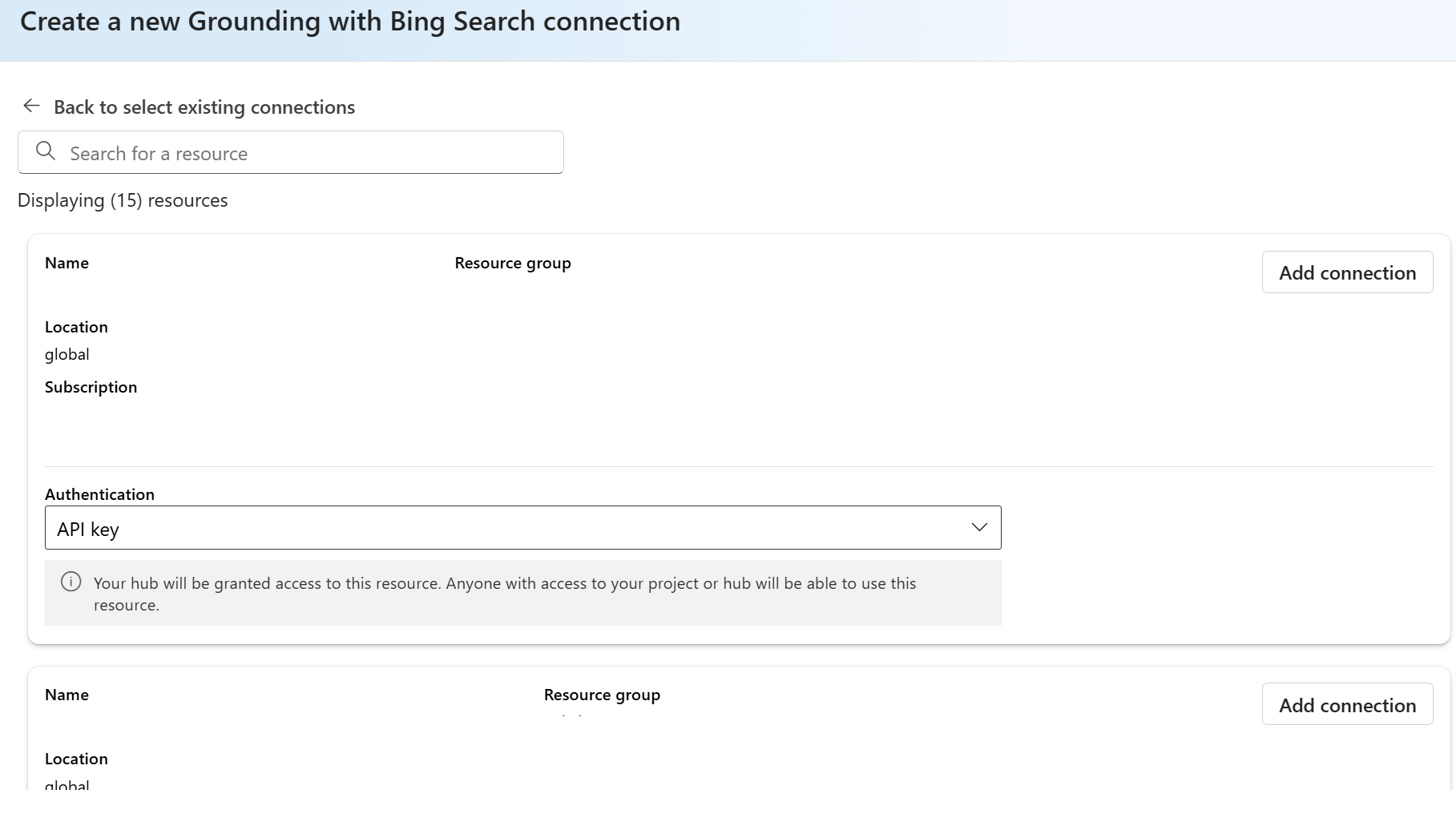Note
Access to this page requires authorization. You can try signing in or changing directories.
Access to this page requires authorization. You can try changing directories.
Use this article to find step-by-step instructions and code samples for Grounding with Bing search.
Prerequisites
- A connected Grounding with Bing Search resource.
- Your connection ID needs to be in this format:
/subscriptions/<subscription_id>/resourceGroups/<resource_group_name>/providers/Microsoft.CognitiveServices/accounts/<ai_service_name>/projects/<project_name>/connections/<connection_name>
Important
There are requirements for displaying Grounding with Bing Search results. See the overview article for details.
In the Azure AI Foundry portal navigate to the Agents screen for your agent, scroll down the Setup pane on the right to knowledge. Then select Add.
Select Grounding with Bing Search and follow the prompts to add the tool. Note you can add only one per agent.
Click to add new connections. Once you have added a connection, you can directly select from existing list.
Select the Grounding with Bing Search resource you want to use and click to add connection.
Create a project client
Create a client object, which will contain the endpoint for connecting to your AI project and other resources.
import os
from azure.ai.projects import AIProjectClient
from azure.identity import DefaultAzureCredential
from azure.ai.agents.models import BingGroundingTool
# Create an Azure AI Client from an endpoint, copied from your Azure AI Foundry project.
# You need to login to Azure subscription via Azure CLI and set the environment variables
project_endpoint = os.environ["PROJECT_ENDPOINT"] # Ensure the PROJECT_ENDPOINT environment variable is set
# Create an AIProjectClient instance
project_client = AIProjectClient(
endpoint=project_endpoint,
credential=DefaultAzureCredential() # Use Azure Default Credential for authentication
)
Create an Agent with the Grounding with Bing search tool enabled
To make the Grounding with Bing search tool available to your agent, use a connection to initialize the tool and attach it to the agent. You can find your connection in the connected resources section of your project in the Azure AI Foundry portal.
conn_id = os.environ["BING_CONNECTION_NAME"] # Ensure the BING_CONNECTION_NAME environment variable is set
# Initialize the Bing Grounding tool
bing = BingGroundingTool(connection_id=conn_id)
with project_client:
# Create an agent with the Bing Grounding tool
agent = project_client.agents.create_agent(
model=os.environ["MODEL_DEPLOYMENT_NAME"], # Model deployment name
name="my-agent", # Name of the agent
instructions="You are a helpful agent", # Instructions for the agent
tools=bing.definitions, # Attach the Bing Grounding tool
)
print(f"Created agent, ID: {agent.id}")
Create a thread
# Create a thread for communication
thread = project_client.agents.threads.create()
print(f"Created thread, ID: {thread.id}")
# Add a message to the thread
message = project_client.agents.messages.create(
thread_id=thread.id,
role="user", # Role of the message sender
content="What is the weather in Seattle today?", # Message content
)
print(f"Created message, ID: {message['id']}")
Create a run and check the output
Create a run and observe that the model uses the Grounding with Bing Search tool to provide a response to the user's question.
# Create and process an agent run
run = project_client.agents.runs.create_and_process(
thread_id=thread.id,
agent_id=agent.id,
# tool_choice={"type": "bing_grounding"} # optional, you can force the model to use Grounding with Bing Search tool
)
print(f"Run finished with status: {run.status}")
# Check if the run failed
if run.status == "failed":
print(f"Run failed: {run.last_error}")
# Fetch and log all messages
messages = project_client.agents.messages.list(thread_id=thread.id)
for message in messages:
print(f"Role: {message.role}, Content: {message.content}")
Optionally output the run steps used by the agent
run_steps = project_client.agents.run_steps.list(thread_id=thread.id, run_id=run.id)
for step in run_steps:
print(f"Step {step['id']} status: {step['status']}")
# Check if there are tool calls in the step details
step_details = step.get("step_details", {})
tool_calls = step_details.get("tool_calls", [])
if tool_calls:
print(" Tool calls:")
for call in tool_calls:
print(f" Tool Call ID: {call.get('id')}")
print(f" Type: {call.get('type')}")
function_details = call.get("function", {})
if function_details:
print(f" Function name: {function_details.get('name')}")
print() # add an extra newline between steps
Delete the agent when done
project_client.agents.delete_agent(agent.id)
print("Deleted agent")
Create a project client
Create a client object, which will contain the project endpoint for connecting to your AI project and other resources.
using Azure;
using Azure.AI.Agents.Persistent;
using Azure.Identity;
var projectEndpoint = System.Environment.GetEnvironmentVariable("ProjectEndpoint");
var projectEndpoint = System.Environment.GetEnvironmentVariable("ModelDeploymentName");
var projectEndpoint = System.Environment.GetEnvironmentVariable("BingConnectionId");
// Create the Agent Client
PersistentAgentsClient agentClient = new(projectEndpoint, new DefaultAzureCredential());
Create an Agent with the Grounding with Bing search tool enabled
To make the Grounding with Bing search tool available to your agent, use a connection to initialize the tool and attach it to the agent. You can find your connection in the connected resources section of your project in the Azure AI Foundry portal.
BingGroundingToolDefinition bingGroundingTool = new(
new BingGroundingSearchToolParameters(
[new BingGroundingSearchConfiguration(bingConnectionId)]
)
);
// Create the Agent
PersistentAgent agent = agentClient.Administration.CreateAgent(
model: modelDeploymentName,
name: "my-agent",
instructions: "Use the bing grounding tool to answer questions.",
tools: [bingGroundingTool]
);
Create a thread and run
PersistentAgentThread thread = agentClient.Threads.CreateThread();
// Create message and run the agent
PersistentThreadMessage message = agentClient.Messages.CreateMessage(
thread.Id,
MessageRole.User,
"How does wikipedia explain Euler's Identity?");
ThreadRun run = agentClient.Runs.CreateRun(thread, agent);
Wait for the agent to complete and print the output
First, wait for the agent to complete the run by polling its status. Observe that the model uses the Grounding with Bing Search tool to provide a response to the user's question.
// Wait for the agent to finish running
do
{
Thread.Sleep(TimeSpan.FromMilliseconds(500));
run = agentClient.Runs.GetRun(thread.Id, run.Id);
}
while (run.Status == RunStatus.Queued
|| run.Status == RunStatus.InProgress);
// Confirm that the run completed successfully
if (run.Status != RunStatus.Completed)
{
throw new Exception("Run did not complete successfully, error: " + run.LastError?.Message);
}
Then, retrieve and process the messages from the completed run.
// Retrieve all messages from the agent client
Pageable<PersistentThreadMessage> messages = agentClient.Messages.GetMessages(
threadId: thread.Id,
order: ListSortOrder.Ascending
);
// Process messages in order
foreach (PersistentThreadMessage threadMessage in messages)
{
Console.Write($"{threadMessage.CreatedAt:yyyy-MM-dd HH:mm:ss} - {threadMessage.Role,10}: ");
foreach (MessageContent contentItem in threadMessage.ContentItems)
{
if (contentItem is MessageTextContent textItem)
{
string response = textItem.Text;
// If we have Text URL citation annotations, reformat the response to show title & URL for citations
if (textItem.Annotations != null)
{
foreach (MessageTextAnnotation annotation in textItem.Annotations)
{
if (annotation is MessageTextUriCitationAnnotation urlAnnotation)
{
response = response.Replace(urlAnnotation.Text, $" [{urlAnnotation.UriCitation.Title}]({urlAnnotation.UriCitation.Uri})");
}
}
}
Console.Write($"Agent response: {response}");
}
else if (contentItem is MessageImageFileContent imageFileItem)
{
Console.Write($"<image from ID: {imageFileItem.FileId}");
}
Console.WriteLine();
}
}
Optionally output the run steps used by the agent
// Retrieve the run steps used by the agent and print those to the console
Console.WriteLine("Run Steps used by Agent:");
Pageable<RunStep> runSteps = agentClient.Runs.GetRunSteps(run);
foreach (var step in runSteps)
{
Console.WriteLine($"Step ID: {step.Id}, Total Tokens: {step.Usage.TotalTokens}, Status: {step.Status}, Type: {step.Type}");
if (step.StepDetails is RunStepMessageCreationDetails messageCreationDetails)
{
Console.WriteLine($" Message Creation Id: {messageCreationDetails.MessageCreation.MessageId}");
}
else if (step.StepDetails is RunStepToolCallDetails toolCallDetails)
{
// We know this agent only has the Bing Grounding tool, so we can cast it directly
foreach (RunStepBingGroundingToolCall toolCall in toolCallDetails.ToolCalls)
{
Console.WriteLine($" Tool Call Details: {toolCall.GetType()}");
foreach (var result in toolCall.BingGrounding)
{
Console.WriteLine($" {result.Key}: {result.Value}");
}
}
}
}
Clean up resources
Clean up the resources from this sample.
// Delete thread and agent
agentClient.Threads.DeleteThread(threadId: thread.Id);
agentClient.Administration.DeleteAgent(agentId: agent.Id);
Create a project client
Create a client object, which will contain the endpoint for connecting to your AI project and other resources.
const { AgentsClient, ToolUtility, isOutputOfType } = require("@azure/ai-agents");
const { delay } = require("@azure/core-util");
const { DefaultAzureCredential } = require("@azure/identity");
require("dotenv/config");
const projectEndpoint = process.env["PROJECT_ENDPOINT"];
// Create an Azure AI Client
const client = new AgentsClient(projectEndpoint, new DefaultAzureCredential());
Create an Agent with the Grounding with Bing search tool enabled
To make the Grounding with Bing search tool available to your agent, use a connection to initialize the tool and attach it to the agent. You can find your connection in the connected resources section of your project in the Azure AI Foundry portal.
const connectionId = process.env["AZURE_BING_CONNECTION_ID"] || "<connection-name>";
// Initialize agent bing tool with the connection id
const bingTool = ToolUtility.createBingGroundingTool([{ connectionId: connectionId }]);
// Create agent with the bing tool and process assistant run
const agent = await client.createAgent("gpt-4o", {
name: "my-agent",
instructions: "You are a helpful agent",
tools: [bingTool.definition],
});
console.log(`Created agent, agent ID : ${agent.id}`);
Create a thread
// Create thread for communication
const thread = await client.threads.create();
console.log(`Created thread, thread ID: ${thread.id}`);
// Create message to thread
const message = await client.messages.create(
thread.id,
"user",
"How does wikipedia explain Euler's Identity?",
);
console.log(`Created message, message ID : ${message.id}`);
Create a run and check the output
Create a run and observe that the model uses the Grounding with Bing Search tool to provide a response to the user's question.
// Create and process agent run in thread with tools
let run = await client.runs.create(thread.id, agent.id);
while (run.status === "queued" || run.status === "in_progress") {
await delay(1000);
run = await client.runs.get(thread.id, run.id);
}
if (run.status === "failed") {
console.log(`Run failed: ${run.lastError?.message}`);
}
console.log(`Run finished with status: ${run.status}`);
// Delete the assistant when done
await client.deleteAgent(agent.id);
console.log(`Deleted agent, agent ID: ${agent.id}`);
// Fetch and log all messages
const messagesIterator = client.messages.list(thread.id);
console.log(`Messages:`);
// Get the first message
const firstMessage = await messagesIterator.next();
if (!firstMessage.done && firstMessage.value) {
const agentMessage = firstMessage.value.content[0];
if (isOutputOfType(agentMessage, "text")) {
const textContent = agentMessage;
console.log(`Text Message Content - ${textContent.text.value}`);
}
}
Important
- This REST API allows developers to invoke the Grounding with Bing Search tool through the Azure AI Foundry Agent Service. It does not send calls to the Grounding with Bing Search API directly.
Follow the REST API Quickstart to set the right values for the environment variables AGENT_TOKEN, AZURE_AI_FOUNDRY_PROJECT_ENDPOINT and API_VERSION.
Create an Agent with the Grounding with Bing search tool enabled
To make the Grounding with Bing search tool available to your agent, use a connection to initialize the tool and attach it to the agent. You can find your connection in the connected resources section of your project in the Azure AI Foundry portal.
curl --request POST \
--url $AZURE_AI_FOUNDRY_PROJECT_ENDPOINT/assistants?api-version=$API_VERSION \
-H "Authorization: Bearer $AGENT_TOKEN" \
-H "Content-Type: application/json" \
-d '{
"instructions": "You are a helpful agent.",
"name": "my-agent",
"model": "gpt-4o",
"tools": [
{
"type": "bing_grounding",
"bing_grounding": {
"search_configurations": [
{
"connection_id": "<your_connection_id>",
"count": 7,
"market": "en-US",
"set_lang": "en",
"freshness": "7d",
}
]
}
}
]
}'
Create a thread
curl --request POST \
--url $AZURE_AI_FOUNDRY_PROJECT_ENDPOINT/threads?api-version=$API_VERSION \
-H "Authorization: Bearer $AGENT_TOKEN" \
-H "Content-Type: application/json" \
-d ''
Add a user question to the thread
curl --request POST \
--url $AZURE_AI_FOUNDRY_PROJECT_ENDPOINT/threads/thread_abc123/messages?api-version=$API_VERSION \
-H "Authorization: Bearer $AGENT_TOKEN" \
-H "Content-Type: application/json" \
-d '{
"role": "user",
"content": "What is the weather in Seattle?"
}'
Create a run and check the output
Create a run and observe that the model uses the Grounding with Bing Search tool to provide a response to the user's question.
curl --request POST \
--url $AZURE_AI_FOUNDRY_PROJECT_ENDPOINT/threads/thread_abc123/runs?api-version=$API_VERSION \
-H "Authorization: Bearer $AGENT_TOKEN" \
-H "Content-Type: application/json" \
-d '{
"assistant_id": "asst_abc123",
}'
Retrieve the status of the run
curl --request GET \
--url $AZURE_AI_FOUNDRY_PROJECT_ENDPOINT/threads/thread_abc123/runs/run_abc123?api-version=$API_VERSION \
-H "Authorization: Bearer $AGENT_TOKEN"
Retrieve the agent response
curl --request GET \
--url $AZURE_AI_FOUNDRY_PROJECT_ENDPOINT/threads/thread_abc123/messages?api-version=$API_VERSION \
-H "Authorization: Bearer $AGENT_TOKEN"
Code example
package com.example.agents;
import com.azure.ai.agents.persistent.MessagesClient;
import com.azure.ai.agents.persistent.PersistentAgentsAdministrationClient;
import com.azure.ai.agents.persistent.PersistentAgentsClient;
import com.azure.ai.agents.persistent.PersistentAgentsClientBuilder;
import com.azure.ai.agents.persistent.RunsClient;
import com.azure.ai.agents.persistent.ThreadsClient;
import com.azure.ai.agents.persistent.models.BingGroundingSearchConfiguration;
import com.azure.ai.agents.persistent.models.BingGroundingSearchToolParameters;
import com.azure.ai.agents.persistent.models.BingGroundingToolDefinition;
import com.azure.ai.agents.persistent.models.CreateAgentOptions;
import com.azure.ai.agents.persistent.models.CreateRunOptions;
import com.azure.ai.agents.persistent.models.MessageImageFileContent;
import com.azure.ai.agents.persistent.models.MessageRole;
import com.azure.ai.agents.persistent.models.MessageTextContent;
import com.azure.ai.agents.persistent.models.PersistentAgent;
import com.azure.ai.agents.persistent.models.PersistentAgentThread;
import com.azure.ai.agents.persistent.models.RunStatus;
import com.azure.ai.agents.persistent.models.ThreadMessage;
import com.azure.ai.agents.persistent.models.ThreadRun;
import com.azure.ai.agents.persistent.models.MessageContent;
import com.azure.core.http.rest.PagedIterable;
import com.azure.identity.DefaultAzureCredentialBuilder;
import java.util.Arrays;
public class AgentExample {
public static void main(String[] args) {
// variables for authenticating requests to the agent service
String projectEndpoint = System.getenv("PROJECT_ENDPOINT");
String modelName = System.getenv("MODEL_DEPLOYMENT_NAME");
String bingConnectionId = System.getenv("BING_CONNECTION_ID");
PersistentAgentsClientBuilder clientBuilder = new PersistentAgentsClientBuilder().endpoint(projectEndpoint)
.credential(new DefaultAzureCredentialBuilder().build());
PersistentAgentsClient agentsClient = clientBuilder.buildClient();
PersistentAgentsAdministrationClient administrationClient = agentsClient.getPersistentAgentsAdministrationClient();
ThreadsClient threadsClient = agentsClient.getThreadsClient();
MessagesClient messagesClient = agentsClient.getMessagesClient();
RunsClient runsClient = agentsClient.getRunsClient();
BingGroundingSearchConfiguration searchConfiguration = new BingGroundingSearchConfiguration(bingConnectionId);
BingGroundingSearchToolParameters searchToolParameters
= new BingGroundingSearchToolParameters(Arrays.asList(searchConfiguration));
BingGroundingToolDefinition bingGroundingTool = new BingGroundingToolDefinition(searchToolParameters);
String agentName = "bing_grounding_example";
CreateAgentOptions createAgentOptions = new CreateAgentOptions(modelName)
.setName(agentName)
.setInstructions("You are a helpful agent")
.setTools(Arrays.asList(bingGroundingTool));
PersistentAgent agent = administrationClient.createAgent(createAgentOptions);
PersistentAgentThread thread = threadsClient.createThread();
ThreadMessage createdMessage = messagesClient.createMessage(
thread.getId(),
MessageRole.USER,
"How does wikipedia explain Euler's Identity?");
try {
//run agent
CreateRunOptions createRunOptions = new CreateRunOptions(thread.getId(), agent.getId())
.setAdditionalInstructions("");
ThreadRun threadRun = runsClient.createRun(createRunOptions);
waitForRunCompletion(thread.getId(), threadRun, runsClient);
printRunMessages(messagesClient, thread.getId());
} catch (InterruptedException e) {
throw new RuntimeException(e);
} finally {
//cleanup
threadsClient.deleteThread(thread.getId());
administrationClient.deleteAgent(agent.getId());
}
}
// A helper function to print messages from the agent
public static void printRunMessages(MessagesClient messagesClient, String threadId) {
PagedIterable<ThreadMessage> runMessages = messagesClient.listMessages(threadId);
for (ThreadMessage message : runMessages) {
System.out.print(String.format("%1$s - %2$s : ", message.getCreatedAt(), message.getRole()));
for (MessageContent contentItem : message.getContent()) {
if (contentItem instanceof MessageTextContent) {
System.out.print((((MessageTextContent) contentItem).getText().getValue()));
} else if (contentItem instanceof MessageImageFileContent) {
String imageFileId = (((MessageImageFileContent) contentItem).getImageFile().getFileId());
System.out.print("Image from ID: " + imageFileId);
}
System.out.println();
}
}
}
// a helper function to wait until a run has completed running
public static void waitForRunCompletion(String threadId, ThreadRun threadRun, RunsClient runsClient)
throws InterruptedException {
do {
Thread.sleep(500);
threadRun = runsClient.getRun(threadId, threadRun.getId());
}
while (
threadRun.getStatus() == RunStatus.QUEUED
|| threadRun.getStatus() == RunStatus.IN_PROGRESS
|| threadRun.getStatus() == RunStatus.REQUIRES_ACTION);
if (threadRun.getStatus() == RunStatus.FAILED) {
System.out.println(threadRun.getLastError().getMessage());
}
}
}



